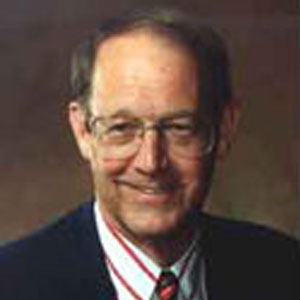Emeritus Professor
Contact Information
- Office Address: 419 Dougherty Hall
- Phone: 865-974-2421
- E-mail: collier@utk.edu
Education
- BS ChE, South Dakota School of Mines, 1961
- MS ChE, University of Illinois, 1962
- PhD Poly, Case Western Reserve University, 1966
Research
John R. Collier became Professor and Head of Chemical Engineering in June 1999, coming from LSU and previously Ohio University. Besides being Faculty Senate President, Chemical Engineering Department Chair and Associate Director of the Recyclable Materials Institute at LSU, he also was an Associate Dean of the Graduate College and Research Institute at Ohio University.
His research interest involve polymer and textile processing and properties with particular emphasis on the influence of elongational and shear rheology on processing and subsequent properties. He is also involved in research related to conversion of agricultural and industrial residues to value added products. Collier teaches courses in fluids, rheology, and polymer processing.
Elongational Rheology: Collier developed and patented a technique for measuring the elongational rheology and orientability of polymer melts and concentrated solutions at processing elongational strain rates. This technique features replacing the normal constant diameter capillary dies in a capillary rheometer with hyperbolically converging dies.
The Hencky strain (natural logarithm of the area reduction) of these dies can be as high as 7 indicating an area reduction of 1,100. Since the research using these dies demonstrates that the body forces related to orientation development of polymer melts and concentration solutions in this converging flow are more than three orders of magnitude higher than shear forces due to wall effects, the flow is in essentially a pure elongational flow. The channel geometry dictates that the elongational strain rate is constant, the particular value set by the volumetric flow rate and specific hyperbolic geometry; therefore the fluid experiences a linearly accelerating, elongating plug flow. Research is continuing using elongational rheology to characterize the orientability of polymer melts and solutions as a function of molecular characteristics. A major advantage of orientation development in hyperbolically convergent channels is that the flow is steady and homogeneous, and in a compressive mode rather than the commercially common tensile mode.
On-line Process Control Sensors: On-line elongational rheology measurements and shear rheology measurements are being coupled to control processes with intentional and incidental orientation development such as fiber spinning and blowing, film tentering and bubble blowing, profile extrusion and injection molding. The elongational rheology control the orientation development of the polymer melt or concentrated solution, and the shear rheology control the flow through shaping dies and channels. Sensors are being developed using the hyperbolic convergent technology for this application.
Lyocell Solutions: Collier and his wife, Billie Collier, Professor of Textiles and Associate Dean of Human Ecology, continue to be involved in determining and using the characteristics of lyocell solutions, specifically cellulose dissolved in N-methyl morpholine N oxide monohydrate (NMMO). NMMO is the solvent used in producing Tencel® and Lyocell® cellulosic manufactured fibers. NMMO is an environmentally friendly, biodegradable solvent and its use in manufactured fibers is replacing the viscose rayon process. This research includes elongational flow induced phase separation from an apparent liquid crystalline phase and characterization of the cellulosic fibers.
Micro-machining: John Collier has been involved in the production of multiple copies of synchrotron micro-machined parts by enhancing the fabrication processes of injection and compression molding. Cooperative research is being initiated with Mary Helen McCay of UT’s Laser Processing Center to scale down the hyperbolic convergent geometry sufficiently to produce spinnerets and smaller dies for enhanced orientation development and characterization.
Nonwoven Processing and Products: Both Colliers are involved with characterization of polymers for melt blown and spun bonded nonwoven fabrics and modeling of these process at the UT Textiles and Nonwoven Development Center (TANDEC). They have also developed a patented process for conversion of bagasse (cellulosic residual material from crushing sugar cane) or kenaf to fiber bundles than can be converted to value added products. Superior erosion control mats formed by suspension deposition of these fiber bundles have been demonstrated. Furthermore in conjunction with Ioan Negulescu and Jonathan Chen at LSU, research is continuing on spinning, weaving and knitting these bundles into other products.
Publications
- S. Petrovan, J.R. Collier, and I.I. Negulescu, "Rheology of Cellulosic N-Methylmorpholine Oxide Monohydrate Solutions of Different Degrees of Polymerization," Journal of Applied Polymer Science, 79, 396-405, 2001.
- S. Petrovan, J.R. Collier, and J.H. Morton, "Rheology of Cellulosic N-Methylmorpholine Oxide Monohydrate Solutions," Journal of Applied Polymer Science, 77, 1369-1377, 2000.
- M.S. Despa, K.W. Kelly, and J.R. Collier, "Injection Molding of Polymeric LIGA HARMs," Microsystem Technologies 6, 60-66, 1999.
- M.S. Despa, K.W. Kelly, and J.R. Collier, "Injection Molding of Polymeric LIGA HARMs," Microsystem Technologies 6, 60-66, 1999.
- J.R. Collier, O. Romanoschi, and S. Petrovan, "Elongational Rheology of Polymer Melts and Solutions," Journal of Applied Polymer Science, 69, 2357-2367, 1998.
- John R. Collier, and Billie J. Collier, US Patent 5,718,802, Process for Obtaining Cellulosic Fiber Bundles At Least 2.5 cm Long From Plant Stalk Rind, February 17, 1998.
- I.I. Negulescu, H.J. Kwon, B.J. Collier, J.R. Collier, and A. Pendse, "A Scheme for Recycling Cotton from Cotton/Polyester Fabrics," Textile Chemist and Colorist, 30, #6, 31-35, June, 1998
- O. Romanoschi, S. Romanoschi, J.R. Collier, and B.J. Collier, "Optimization of Process Variables for Alkali Delignification," Cellulose Chemistry and Technology, 32 (1-2), 107-120, 1998
- John R. Collier, U.S. Patent 5,357,784, Lubricated Flow Elongational Rheometer, October 25, 1994.
- John R. Collier, U.S. Patent 5,357,784, Lubricated Flow Elongational Rheometer, October 25, 1994.
- S. Romanoschi, B.J. Collier, O. Romanoschi, and J.R. Collier, "Bleaching and Dyeing of Kenaf Fibers," 195-202; Kenaf Properties, Processing and Products, ed. Terry Sellers, Jr. and Nancy A. Reichert, Mi.
- O. Romanoschi, J.R. Collier, B.J. Collier, I.I. Negulescu, and S. Petrovan, "Rheological Properties of Kenaf Lyocell Solutions;" 225-244; Kenaf Properties, Processing and Products, ed. Terry Sellers, Jr.
- O. Romanoschi, S. Romanoschi, J.R. Collier, and B.J. Collier; "Value-Added Geotextile Products Made from Kenaf;" 245-256; Kenaf Properties, Processing and Products, ed. Terry Sellers, Jr. and Nancy A. R.
